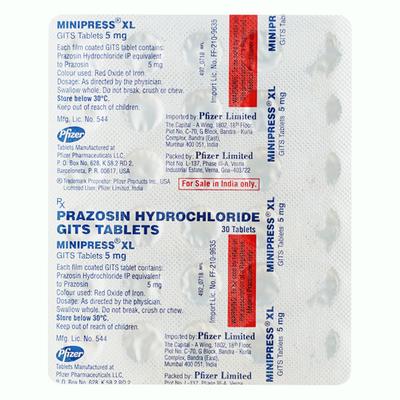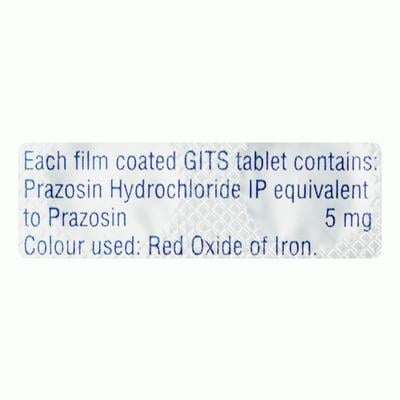

Netmeds First Membership
Quick Links
Introduction About MINIPRESS XL 5MG TABLET
MINIPRESS XL 5MG TABLET contains Prazosin which belongs to the group of medicines called Alpha-Blockers. It is used for managing high blood pressure (hypertension), heart failure, benign prostatic hyperplasia (enlarged prostate), and Raynaud’s disease (painful cold fingers).
Controlling high blood pressure (hypertension) lowers the risk of heart attack or stroke. This medicine may be prescribed alone or alongside other medicines. Take it regularly and follow the dose and duration prescribed by your doctor. Since high blood pressure usually has no symptoms, continue taking it even if you feel well.
The most common side effects of this medicine include weakness, dizziness, headache, nausea, palpitations (unusual heart beating), drowsiness, fatigue, and light headedness. Most of these effects tend to improve as your body adjusts to the medicine. It may also cause blood pressure to drop too low, especially when starting the medicine. Your doctor can offer guidance to help reduce or manage these side effects effectively.
If you are pregnant, planning to become pregnant, or breastfeeding, consult your doctor before using this medicine. Inform your doctor if you have a history of heart failure, liver disease, kidney disease, or if you are scheduled for cataract eye surgery. Your blood pressure will be monitored regularly during management to ensure safe and effective use.
Uses Of MINIPRESS XL 5MG TABLET
- High blood pressure (hypertension)
- Heart failure
- Benign prostatic hyperplasia (enlarged prostate)
- Raynaud’s disease (painful cold fingers)
Benefits of MINIPRESS XL 5MG TABLET
01)Supports Blood Pressure Control: MINIPRESS XL 5MG TABLET helps relax blood vessels, allowing blood to flow more easily and supporting the management of high blood pressure (hypertension).
02)Enhances Heart Function: This medicine aids in improving heart performance in individuals with heart failure by reducing the strain on the heart through better blood circulation.
03)Eases Urinary Symptoms of Enlarged Prostate: The active ingredient prazosin relaxes muscles around the bladder and prostate, improving urine flow and reducing symptoms of benign prostatic hyperplasia.
04)Improves Circulation in Raynaud’s Disease: MINIPRESS XL 5MG TABLET helps enhance blood flow to fingers, reducing coldness and discomfort associated with Raynaud’s disease.
05)Reduces Risk of Cardiovascular Events: By maintaining controlled blood pressure, it lowers the potential risk of heart attacks and strokes.
06)Suitable for Long-Term Use Under Doctor’s Guidance: Regular use as prescribed helps maintain overall cardiovascular and urinary health safely.
How MINIPRESS XL 5MG TABLET Works
How MINIPRESS XL 5MG TABLET Works in the Body
MINIPRESS XL 5MG TABLET works by relaxing the muscles in blood vessel walls and around the prostate gland. This leads to widened blood vessels, making it easier for blood to flow and lowering blood pressure. It also eases urinary flow by relaxing muscles around the bladder and prostate.
Mechanism of Action of MINIPRESS XL 5MG TABLET
MINIPRESS XL 5MG TABLET contains prazosin, an alpha-1 adrenergic receptor blocker. It inhibits these receptors found in vascular smooth muscle, reducing the narrowing of blood vessels. This blockade reduces peripheral vascular resistance, supporting controlled blood pressure and better circulation.
Role of Alpha-1 Adrenergic Receptor Blockade
The alpha-1 receptor blockade stops catecholamines (like norepinephrine) from causing blood vessels to constrict. This action relaxes the vessel walls, reduces vascular resistance, and helps in lowering blood pressure. It also relaxes muscles in the prostate and bladder region.
Effects of MINIPRESS XL 5MG TABLET on Blood Vessel Relaxation
By relaxing blood vessel muscles, MINIPRESS XL 5MG TABLET causes vasodilation, which reduces the effort the heart needs to pump blood. This dilation supports improved blood flow and helps maintain balanced blood pressure levels throughout the body.
How MINIPRESS XL 5MG TABLET Supports Blood Flow and Pressure Control
MINIPRESS XL 5MG TABLET facilitates easier blood movement by widening blood vessels and lowering resistance. It reduces workload on the heart while improving organ perfusion. This supports effective management of hypertension, heart failure, and symptoms of an enlarged prostate.
Pharmacodynamics and Safe Use of MINIPRESS XL 5MG TABLET
Pharmacodynamically, MINIPRESS XL 5MG TABLET lowers blood pressure without causing a rapid heart rate increase. It is metabolized by the liver and has an onset of action within 30 to 90 minutes. With regular medical supervision, it safely supports cardiovascular health while improving urinary comfort.
How to use MINIPRESS XL 5MG TABLET
How to Use MINIPRESS XL 5MG TABLET Safely
Take MINIPRESS XL 5MG TABLET exactly as prescribed by your doctor. Swallow the tablet whole with water, with or without food, and do not crush or chew. Following your doctor's instructions ensures optimal absorption and effectiveness.
Recommended Dosage and Administration
The usual starting dose is 2.5 mg once daily. Depending on your response, the dose may be gradually increased by your doctor up to 20 mg daily in divided doses. Dosage adjustments are personalized based on blood pressure control and tolerance.
Best Time to Take MINIPRESS XL 5MG TABLET
It is best to take MINIPRESS XL 5MG TABLET at the same time each day, preferably after meals, to maintain consistent blood levels and reduce the chance of low blood pressure episodes.
Important Directions for MINIPRESS XL 5MG TABLET Use
Do not stop taking MINIPRESS XL 5MG TABLET suddenly, as this can cause a rapid increase in blood pressure. Inform your doctor of all medications you are taking and any pre-existing health conditions before starting therapy.
Dosage Adjustments and Monitoring
Your doctor will monitor your blood pressure regularly and may adjust the dose if needed. Inform your healthcare provider about any side effects, especially dizziness or light headedness, which may occur when standing up quickly.
Safety Tips During MINIPRESS XL 5MG TABLET Therapy
Avoid driving or operating heavy machinery if you experience dizziness or drowsiness. Stay hydrated and rise slowly from sitting or lying positions to minimize light headedness. Report any persistent side effects to your doctor.
What if I forgot to take MINIPRESS XL 5MG TABLET
If you miss a dose, take it as soon as you remember unless it is near the time for your next dose. Do not double the dose to make up for a missed one. Maintaining a regular dosing schedule is important.
Side Effects Of MINIPRESS XL 5MG TABLET
Common:
- Weakness
- Dizziness
- Headache
- Nausea
- Palpitations (unusual heart beating)
- Drowsiness
- Fatigue
- Light headedness
When to consult your doctor?
- Signs of low blood pressure such as sudden dizziness, feeling lightheaded, or fainting when standing up
- Severe allergic reactions such as swelling of the face, lips, tongue, or throat, difficulty breathing, and rash or hives
- Rapid, pounding, or irregular heartbeat (palpitations)
- Persistent, painful erection lasting more than 4 hours (priapism)
- Chest pain or tightness
- Shortness of breath or difficulty breathing
- Confusion or blurred vision
- Severe stomach cramps or joint pain
- Swelling of hands, feet, or ankles
How To Manage Side Effects
Dizziness Or Drowsiness
- Sit or Lie Down: If you feel dizzy, sit down, or lie down immediately to reduce falling. Keep your head still and close your eyes if needed.
- Hydrate: Dehydration can cause dizziness, so drink water or electrolyte-replenishing drinks like sports drinks.
- Avoid Sudden Movements: When standing or sitting, do so slowly to avoid triggering dizziness. Take your time when getting up.
- Eat Small, Regular Meals: Low blood sugar can cause dizziness, so eat small meals throughout the day and avoid skipping meals.
- Fresh Air: Sometimes dizziness can be alleviated by taking slow, deep breaths in a well-ventilated area.
Headache
- Stay Hydrated: Drink plenty of water throughout the day to help ease headache symptoms.
- Rest in a Quiet Environment: Minimize noise and bright lights by resting in a calm, dark room.
- Use Over-the-Counter Pain Relief: Consult your doctor about using mild pain relievers like acetaminophen to alleviate headaches.
- Avoid Stressful Activities: Limit activities that increase stress or physical exertion when experiencing headaches.
- Seek Medical Advice: Contact your healthcare provider if headaches become severe, persistent, or are accompanied by other symptoms.
Nausea And Vomiting
- Stay Hydrated: Sip fluids slowly, such as water, ginger tea, or clear soups to support hydration and reduce discomfort.
- Eat Small, Bland Meals: Choose light foods like crackers, toast, or plain rice to minimize stomach irritation.
- Avoid Strong Odors and Spicy Foods: These can worsen feelings of nausea and should be limited during symptoms.
- Rest and Relaxation: Rest in a comfortable position and avoid sudden movements to calm the digestive system.
- Seek Medical Advice: Consult a healthcare provider promptly if nausea is severe, persistent, or accompanied by vomiting.
Warning & Precautions
Pregnancy
Monitoring requiredMINIPRESS XL 5MG TABLET should be taken during pregnancy only if your doctor finds it clearly necessary. Consult your doctor before taking it.
Breastfeeding
Use with CautionMINIPRESS XL 5MG TABLET can pass into breast milk in small amounts. Breastfeeding mothers should use this medicine with caution. Consult your doctor before taking it.
Driving and Using Machines
Use with CautionAvoid driving or operating machinery if you feel dizziness, drowsiness, or weakness after taking MINIPRESS XL 5MG TABLET
Alcohol
Consult your doctorDo not consume alcohol while on MINIPRESS XL 5MG TABLET, as it may increase dizziness, light-headedness, or a risk of fainting.
Kidney
Use with CautionMINIPRESS XL 5MG TABLET should be used with caution in patients with kidney disease. Consult your doctor before taking.
Liver
Use with CautionMINIPRESS XL 5MG TABLET should be used with caution in patients with liver disease. Consult your doctor before taking.
Allergy
ContraindicatedDo not take MINIPRESS XL 5MG TABLET if you are allergic to Prazosin or any other quinazoline medicines like doxazosin or terazosin.
Heart Disease
Use with CautionPatients with heart conditions such as heart failure, previous heart attack, or valve problems should take MINIPRESS XL 5MG TABLET cautiously. Long-term use in such cases may cause fluid retention or swelling in legs and ankles. Consult your doctor before taking.
Use In Pediatrics
ContraindicatedMINIPRESS XL 5MG TABLET is not recommended for children under 12 years of age. Consult your doctor before taking.
Use In Geriatrics
Use with CautionMINIPRESS XL 5MG TABLET should be used with caution in elderly patients usually initiating the management with the lowest possible dose. Consult your doctor before taking it.
Other Warnings for MINIPRESS XL 5MG TABLET
Before taking MINIPRESS XL 5MG TABLET, inform your doctor if you:
- Have a history of fainting, especially after passing urine.
- Are scheduled for cataract surgery, as the medicine may affect the eye procedure.
- Experience a prolonged erection lasting more than 4 hours.
Diet and Lifestyle Advice
|
Lifestyle Change |
Description |
Clinical Benefits with MINIPRESS XL 5MG TABLET |
|
DASH Diet |
Emphasizes fruits, vegetables, whole grains, low-fat dairy, and reduced saturated fats and sugar |
Significantly lowers blood pressure by supporting medication effects |
|
Sodium Restriction |
Limit daily sodium intake to less than 2300 mg, ideally 1500 mg |
Enhances blood pressure control by reducing fluid retention and vascular resistance |
|
Regular Aerobic Exercise |
Moderate-intensity activities like walking, cycling, or swimming for at least 150 minutes/week |
Lowers systolic and diastolic blood pressure, improves heart health |
|
Weight Management |
Achieve and maintain a healthy body weight through diet and exercise |
Enhances medication effectiveness and reduces cardiovascular risk |
|
Alcohol Moderation |
Limit alcohol use to ≤1 drink/day for women and ≤2 drinks/day for men |
Reduces blood pressure spikes and improves medication tolerance |
|
Smoking Cessation |
Completely avoid tobacco smoke and nicotine products |
Decreases vascular inflammation, supports better blood pressure response |
|
Stress Reduction |
Incorporate practices such as meditation, yoga, or deep breathing |
May reduce blood pressure variability and improve overall cardiovascular health |
Drug - Drug interaction
01) Antihypertensive Medicines (e.g., Atenolol, Metoprolol, Amlodipine)
- Interaction: Using MINIPRESS XL 5MG TABLET with other blood pressure tablets can cause an excessive drop in blood pressure.
- Effects: May lead to dizziness, fainting, or weakness.
- Management: Blood pressure should be closely monitored. Dosage of one or more medicines may need adjustment by your doctor.
02) Erectile Dysfunction Medicines (e.g., Sildenafil, Tadalafil, Vardenafil)
- Interaction: Co-use with MINIPRESS XL 5MG TABLET can amplify blood pressure-lowering effects.
- Effects: Sudden dizziness, light-headedness, or fainting may occur.
- Management: Inform your doctor before combining. Adjusted dosing or timing may be recommended.
03) Diuretics/Water Tablets (e.g., Furosemide, Hydrochlorothiazide, Spironolactone)
- Interaction: Taking MINIPRESS XL 5MG TABLET with diuretics can enhance lowering of blood pressure.
- Effects: Increased chance of dehydration, frequent urination, and light-headedness.
- Management: Doctor may advise monitoring electrolytes and adjusting doses accordingly.
04) Psychiatric Medicines (e.g., Antidepressants such as Amitriptyline, Antipsychotics such as Haloperidol, Chlorpromazine)
- Interaction: These medicines may interact with MINIPRESS XL 5MG TABLET and worsen dizziness or low blood pressure.
- Effects: Excessive sedation or fainting spells can occur.
- Management: Inform your doctor. Extra caution and gradual dose adjustments are necessary.
05) NSAIDs (e.g., Ibuprofen, Diclofenac, Naproxen)
- Interaction: Long-term use with MINIPRESS XL 5MG TABLET can reduce its blood pressure-lowering effect.
- Effects: May weaken control of high blood pressure.
- Management: Regular blood pressure monitoring is recommended. Doctor may review pain relief alternatives.
Drug - Food interaction
01) Alcohol
- Interaction: Consuming alcohol with MINIPRESS XL 5MG TABLET can increase the risk of side effects and may cause a significant drop in blood pressure.
- Effects: Can lead to dizziness, light-headedness, or fainting—especially when standing up quickly.
- Management: Avoid alcoholic drinks while taking MINIPRESS XL 5MG TABLET; speak to your doctor for advice.
02) Salt-Rich Foods
- Interaction: Taking MINIPRESS XL 5MG TABLET with foods high in salt may reduce the effectiveness of blood pressure control.
- Effects: May interfere with keeping blood pressure levels normal and can worsen hypertension.
- Management: Follow a low-salt diet and discuss dietary habits with your doctor while using MINIPRESS XL 5MG TABLET
03) Natural Licorice
- Interaction: Natural licorice can affect blood pressure and reduce the effectiveness of MINIPRESS XL 5MG TABLET
- Effects: May counteract the antihypertensive action and lead to uncontrolled blood pressure.
- Management: Avoid eating natural licorice during your management, consult your doctor for safe food options.
Synopsis
|
Drug |
: |
Prazosin |
|
Pharmacological Category |
: |
Alpha-Blockers |
|
Therapeutic Indication |
: |
Hypertension, Heart failure, Raynaud’s disease, Benign prostatic hyperplasia |
|
Dosage Forms |
: |
Tablet |
More Information
Storage
- Store MINIPRESS XL 5MG TABLET at room temperature, typically between 20-25°C
- Keep this medication away from direct sunlight, heat sources, and humidity to maintain its effectiveness
- Store the medications in a safe location, out of reach of children and pets
- Never freeze MINIPRESS XL 5MG TABLET, as freezing can damage the medication
FAQs About MINIPRESS XL 5MG TABLET
Q: What is MINIPRESS XL 5MG TABLET used for?
A: MINIPRESS XL 5MG TABLET helps manage high blood pressure (hypertension), heart failure, Raynaud’s disease, and benign prostatic hyperplasia by relaxing blood vessels and muscles to improve blood flow and reduce symptoms.
Q: How does MINIPRESS XL 5MG TABLET work?
A: The active ingredient prazosin in MINIPRESS XL 5MG TABLET works as an alpha-blocker that relaxes blood vessels and muscles around the bladder and prostate, making it easier for blood to flow and urine to pass smoothly.
Q: Can MINIPRESS XL 5MG TABLET be used during pregnancy?
A: MINIPRESS XL 5MG TABLET should only be used during pregnancy if clearly necessary and under medical supervision. Consult your doctor before taking it while pregnant.
Q: Are there any side effects of MINIPRESS XL 5MG TABLET?
A: Common side effects include dizziness, headache, weakness, nausea, and drowsiness. If side effects persist or worsen, consult your doctor promptly.
Q: What should I do if I miss a dose of MINIPRESS XL 5MG TABLET?
A: Take the missed dose as soon as you remember but skip it if it is almost time for your next dose. Do not double the dose to make up for a missed one.
Q: Can MINIPRESS XL 5MG TABLET be taken with other medications?
A: Inform your doctor about all medications you are taking, as MINIPRESS XL 5MG TABLET may interact with other antihypertensives, diuretics, erectile dysfunction drugs, and certain psychiatric medicines.
Q: Is it safe to drink alcohol while taking MINIPRESS XL 5MG TABLET?
A: Avoid alcohol consumption during management because it can increase side effects such as dizziness or light-headedness. Consult your doctor for guidance.
Q: Can I take this medication with food?
A: Yes, it can be taken with or without food as advised by your doctor.
Q: How soon will I notice effects?
A: It may take several weeks for full effects to be noticed, continue usage as directed.
Q: How to buy MINIPRESS XL 5MG TABLET online safely from Netmeds?
A: Visit the official Netmeds website, search for MINIPRESS XL 5MG TABLET, upload a valid doctor’s prescription during checkout, choose a secure payment method, and provide an accurate delivery address. Netmeds will verify your prescription before processing the order to ensure you receive genuine medication safely at your doorstep.
References
1. KD Tripathi MD. Cardiovascular drugs. Essentials of Medical Pharmacology. Eighth Edition, 2019. Page-610.
2. Briggs GG, Freeman RK, editors. A Reference Guide to Fetal and Neonatal Risk: Drugs in Pregnancy and Lactation. 10th ed. Philadelphia, PA: Wolters Kluwer Health; 2015. Page-1145-46.
3. Basquez R, Pippin MM. Prazosin. NIH National Library of Medicine, National centre for biotechnology information. [Revised in 10th May 2022] [Accessed on 18th October 2025] ![]()
4. Kung S, Espinel Z, Lapid MI. Treatment of nightmares with prazosin: a systematic review. [Revised in September 2012] [ Accessed on 18th October 2025] 
5. Pfizer Limited. Electronic Medicines Compendium (EMC); [Revised in October 2020] [Accessed on 18th October 2025] 









